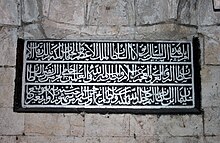Sabil al-Wad
The Sabil al-Wad ( Arabic سبيل الواد, DMG Sabil al-Wad ) is an Ottoman fountain in the old city of Jerusalem .
Surname
The name in Arabic سبيل الواد, DMG Sabil al-Wad (also: Arabic سبيل طريق الواد, DMG Sabil Tariq al-Wad ) received the fountain because it was Arabic in the street طريق الواد, DMG Tariq Al Wad is located. Other names of the fountain are Arabic سبيل محلات باب القطانين, DMG Sabil Mahallat Bab al-Qattanin 'Well of the Shops at the Gate of Cotton' and Arabic سبيل سوق القطانين, DMG Sabil Suq al-Qattanim 'Well of the Cotton Market'. These names originate from the proximity of the well to the alley with the shops of the cotton traders , which leads from the Al Wad to the Bab al-Qattanin (= Gate of Cotton) ⊙ . At the same time they show the concern to supply this district with water with this fountain.
geography
The Sabil al-Wad ⊙ is located in the Muslim Quarter of Jerusalem . It is located 30 m south of the mouth of the Cotton Merchants' Street ⊙ on the east side of Al Wad Street.
description
The sable is framed by a square frame. This frame protrudes from the surrounding wall. The frame is 4.93 m high and about the same width.
Within this frame there is another square frame with a side length of 4.47 m. In the center of this inner frame there is a Gothic pointed arch , the tip of which touches the upper edge of the frame. The pointed arch rests on two richly decorated, 2.6 m high columns.
Above its tip, in the outer frame, there is a relief almost 1.5 m wide and 45 cm high . The center of the relief forms a large rosette directly above the pointed arch tip. To the left and right of her are three smaller rosettes.
In the spandrels there was originally a rosette with a diameter of almost 30 cm. In the field in the arch there were three rosettes arranged in a flat triangle with a diameter of almost 25 cm. Four of these rosettes have been lost. Only the rosette at the top of the triangle has been preserved. On old photos the rosette can still be seen in the left gusset.
The pointed arch protrudes somewhat from the inner frame. It is almost 50 cm wide and profiled with ridges and keel arches . The field in the arch is designed with muqarnas to form a flat vault.
The niche surrounded by the pointed arch and the columns is 3.9 m high and almost 2 m wide at the bottom. There is an inscription in it and, further down, surrounded by a small, flat marble niche, a hole from which the water used to emerge. There is a marble basin underneath.
Behind the Sabil there is a cuboid cistern and the Hammam al-Ain.
Existing elements from the time of the Crusaders were used to design the fountain . This was done on the one hand out of respect and appreciation for the architecture of this past time, on the other hand for reasons of cost savings. The water basin is a marble sarcophagus from the time of the Crusaders. Some elements date from the Mamluk and Ottoman times.
inscription
The inscription:
“He ordered the construction of this blessed Sabil, our master, the Sultan, the greatest Sultan and the honorable Hakan who rules the nations, the Sultan of the countries of Rum , the Arabs and Persians, the glory of Islam and the Muslims, the shadows Allah on earth, the protector of the two sanctuaries, the Sultan Suleyman , the son of the Sultan Selim Khan , may Allah maintain and continue his rule and his sultanate at the beginning of the blessed month of Rajab in the year 943 (December 14th 1536). "
Water supply
The well was supplied with water from a cistern behind it and via the Qanat as-Sabil and its branches.
history
The Sabil was built in 1536 on the orders of Suleiman. A Sharia report preserved in the Sijills of Jerusalem (court documents from the 16th century) mentions the fountain under the name Sabil Mahallat Bab al-Qattanin . In it it is testified that this fountain is one of the nine Sabile that were repaired and made into a waqf by Mohammed Celebi al-Naqqash in 1541 .
It was part of a larger system of about a dozen wells that were built during the Ottoman period. These fountains were built along the pilgrimage route to the Haram and near its gates. They provided the residents and pilgrims with drinking water free of charge.
literature
- Anthony Assetto, Cassidy Hobbs, Joshua Lessard, Judith Bing: Ottoman Sabils of Jerusalem , Drexel University, 2010 online, pdf
Web links
- La Fontaine al Wad short films show different Sabile of Jerusalem and especially the Sabil al-Wad
- Les Fontaines overview of different Sabile of Jerusalem with explanatory films
Individual evidence
- ↑ a b c d e f Ottoman Sabils of Jerusalem at drexel.edu. Retrieved May 27, 2020.
- ↑ The "Ottoman Fountain" in Jerusalem at theologische-links.de. Retrieved May 27, 2020.
- ↑ a b c Denys Pringle : The City of Jerusalem Volume 3 of The Churches of the Crusader Kingdom of Jerusalem: A Corpus. , Cambridge University Press, Cambridge 2006, ISBN 978-0521172837 , pp. 168, 208, 494.Retrieved May 27, 2020 online .
- ↑ Vincent Lemire: La soif de Jérusalem , ED SORBONNE, 2011, ISBN 978-2859446598 , p. 209, the book can be downloaded as a pdf from books.openedition.org. Retrieved May 12, 2020.
- ^ Sabil al-Wad at OSM. Retrieved May 27, 2020.




